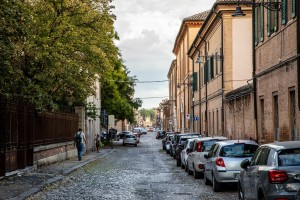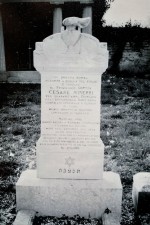Via della Ghiara
Street in the old town of Ferrara that goes from Via Camaleonte to the intersection between Via Porta San Pietro, Via Quartieri and Via XX Settembre.
Name and brief history
Via della Ghiara (or ‘della Ghiaia’) is the ancient name of present-day Via XX Settembre, a section of which was its continuation, as attested to by the street numbers of the houses and the name of the monumental arch at the end of Via XX Settembre, called the ‘Prospettiva della Ghiara’. Designed and built in 1776 by architect Gaetano Genta, the arch is a clear reference to the Prospettiva di Corso Giovecca. The road was named ‘Ghiara’ after the old Po di Primaro river, which deposited ‘gravel’ (ghiaie in Italian), thereby raising and lowering the riverbed. Girolamo Melchiorri mentions this origin of the name, along with the main buildings of the street. First among them is Palazzo Tassoni (also called Palazzo Tassoni Estense), at no. 38 (4930). The Este family had the structure built as part of the ‘Borsian Addition’ (or ‘Second Addition’, Borso d’Este's urban development project, 1451). However, it was later donated to the Tassoni Estensi Counts, along with the ducal surname. It remained family property until 1858, when it became a municipal psychiatric hospital. Opened on 28 October, the ward consisted of a large complex that included courtyards, gardens and a chapel open to the public, as desired by Marquis Filippo Tassoni (1720). Restored in 2009, it is currently the campus of the Architecture School of the University of Ferrara, named after Biagio Rossetti. Further down the road, a building for educational use originally named after local poet Alfonso Varano was built in 1913, in the former orchard of the Augustinian monks of the Church of San Giuseppe. The structure has changed ownership between different institutes over the years. The couplet that appears on a marble slab placed above the arched doorway to the old house at no. 6 is quite interesting: Haec domus hic donec fluctus Formica marinos / Ebibat, et totum testudo perambulat (?) orbem (trad.: ‘may this house stand until an ant has drunk all the water of the sea and a tortoise has gone around the world’).
In the Bassani itinerary
Giorgio Bassani placed the house of Elia Corcos in this street. Thanks to his competence, this fictional Jewish doctor gained the respect of Ferrara's middle class, becoming the head physician at the local hospital and personal doctor to Duchess Costabili, nevertheless paying for the provincialism of the city. Creating a ‘cosy nest’ of a house in Via Ghiara, the character lived there with his family: his wife, Gemma Brondi, their sons Jacopo and Ruben (the latter died in 1902, at eight years old, of meningitis), and his sister-in-law Ausilia, who was secretly in love with him. Via Ghiara was quite dear to Bassani in real life too: the house of his maternal grandparents was there, a place where he spent a lot of time as a child, as mentioned in ‘La Cuginetta Cattolica’ (My Little Catholic Cousin). It is thus no accident that the Elia Corcos character lives in this street: the fictional doctor is in fact based on Bassani's maternal grandfather, Cesare Minerbi, who was the long-time lead physician of Sant’Anna Central Hospital. Even the the inscription of Minerbi's headstone, written by Bassani himself, mentions this important role. It can be admired today in the Jewish Cemetery in Via delle Vigne.
Quotes
‘Just a few years ago the ‘Strada della Ghiaia’ was a continuation of present-day Via XX Settembre, and the numbers on the houses still confirm that fact. And the section that goes from Via Chiovare to Via Camaleonte was called the ‘Strada del Salaro’ after the government monopoly warehouse, or salt depot, located at the end of Via Camaleonte, still commonly called ‘La Salara’. All of the old Via della Ghiaia, or Ghiara, plotted by Marquis Nicolò III, in 1401, where the Po di Primaro was, was thus named for the ghiaie (gravel) deposited by that old river, the bed of which was raised and buried» (G. Melchiorri, Nomenclatura ed Etimologia delle Piazze e delle Strade di Ferrara e Ampliamenti all’Opera di Gerolamo Melchiorri, edited by C. Bassi, 2G Editrice, Ferrara 2009, p. 78s) ‘They were married. At first they lodged with his father, Salomone Corcos, the old grain merchant, and there, in Via Vittoria, in the heart of what until not that long before had been the Ghetto, Jacopo was very soon to be born, and then Ruben. Half a dozen years or so would have to pass before the home in Via della Ghiara would be acquired. To arrive there from the Brondi house, after you had got beyond the little alley on top of the city walls and hadn’t taken any short-cuts, would require a brisk walk of at least a half hour. You’d begin by leaving behind the Borgo San Giorgio, huddled around the big eponymous church with its brown bell tower. You’d continue by hugging the long, blind and monotonous wall of the mental asylum. At length, on the left, at the furthest extreme of the boundless plain, after the blue, wavy line of the Bologna hills begins to become visible, if you turn your head towards the city, your gaze will immediately be drawn to a grey façade, down there, laced about with Virginia creeper, the green blinds closed to protect the occupants from any intrusion of noise: a façade turned towards the south and so exposed to even the most minimal variation of light, with its blanchings and darkenings, its sudden reddenings and alterations, which very much suggested something living, something human. If one looked at it, the house, from high up there on the city walls, one would have thought it a kind of farmhouse... From the opposite side of the house, the front, one would have no idea of all this. It seemed like a dignified little construction of bare redbrick. And each time it seemed incredible...that the countryside whose existence Via della Ghiara, with its reserved and tranquil but still markedly urban aspect, almost made one forget, actually began no more than some fifty or so metres away, only just beyond the final veil of those mainly middle-class, though in some cases even aristocratic, façades, among which, without being harmed by the comparison, was to be found also that of Dr Corcos. (G. Bassani, ‘The Stroll Before Dinner’, translated by Jamie McKendrick in The Novel of Ferrara, Penguin Classics, 2018, e-book location 910-938) ‘It isn’t at all true I was / very happy as a / young man / but as a child incomparably / more // My life took place in that era / in the era of war / in the house of my grandparents in Via / della Ghiara / with grandfather Cesare who, near evening / returned from the clinic or hospital on his bicycle / and that then, standing upright in front / of one of the large windows / of the kitchen / looked towards Bologna the gold of the clouds little by / little fading / and meanwhile he sung softly / sniggering and crying / Leonora addio // She finally arrived from Rome / a pretty daring / brunette / Bruna my little catholic / cousin’ (G. Bassani, ‘La Cuginetta Cattolica’, in In Rima e Senza, Epitaffio, p. 1428s.) ‘In this tomb / near his son’s / Is buried Dr / Cesare Minerbi / For forty years head physician of Sant’Anna Hospital / Ingenious scientist and clinician / of great renown / family doctor to four / generations of Ferrarese // Born in 1856 / when Ferrara was still governed / by the Papal Legates / He died in autumn of 1954 / almost one hundred / Living until the end by his own labour / Passing among us, witty and solitary / with the smile of a sage philosopher / and the distant gaze of one who has looked closely at / pain’ (Lapide sulla tomba di Cesare Minerbi, 1856-1954, presso il cimitero ebraico ferrarese di via delle vigne; parole di G. Bassani)
Bibliography
- Melchiorri, Gerolamo, Bassi, Carlo, Nomenclatura ed etimologia delle piazze e strade di Ferrara. Ampliamenti all'opera di Gerolamo Melchiorri, 2G, Ferrara 2009
- Giorgio Bassani, La passeggiata prima di cena, in Piero Pieri (a cura di), Bassani. Racconti, diari, cronache. 1935-1956, Feltrinelli, Milano 2014
Sitography
- http://architettura.unife.it/it/da-press/palazzo-tassoni-estense
- http://architettura.unife.it/it/Campus/palazzo-tassoni-estense
- https://www.youtube.com/watch?v=wHvpHwOloeo
Fototeca
Compiling entity
- Assessorato alla Cultura e al Turismo, Comune di Ferrara
Author
- Barbara Pizzo


